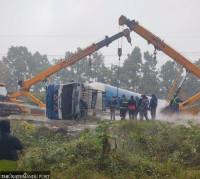National
Snakebite, an invisible neglected crisis in Nepal
Close to 3,000 people die of snakebites every year in Tarai alone, many before reaching the hospital.
Arjun Poudel
In August last year, six-year-old Aayusha Adhikari was bitten by a venomous snake while playing with her friends in a bush near her home in Rangeli of Morang.
Aayusha could not tell what happened to her in the bush, while playing and when her parents knew, it was already late.
“We knew about the incident at around 4:30pm, and by then my daughter had already stopped speaking. Her body was swollen,” Ramesh Adhikari, the father, told the Post over the phone from Morang. “We could not get an ambulance immediately, and when we finally found one, we rushed her to a first aid centre operated by the Nepal Red Cross Society. Health workers there pronounced my daughter dead.”
Incidents of snakebites and resulting deaths are common in Nepal, but the issue still remains grossly neglected and experts call it a lurking invisible crisis.
Each year, around 2,700 people, mostly children and women from Nepal’s Tarai region, die of snake bites, according to a report.
The report titled “Snakebite epidemiology in humans and domestic animals across the Tarai region in Nepal: A multi-cluster random survey”, was prepared jointly by experts at BP Koirala Institute of Health Sciences, Division of Tropical and Humanitarian Medicine, Geneva University Hospital, Institute of Global Health, Department of Community Health and Medicine, Faculty of Medicine, University of Geneva, Institute of Environment Science under Geneva University, Department of Control of Neglected Tropical Disease, World Health Organisation Geneva in 2018 and 2019, is all set to appear in The Lancet, a leading international medical journal, on Tuesday.
Each year, two million people worldwide are bitten by snakes resulting in an estimated 81,000-138,000 deaths.
The World Health Organisation has added snakebite envenoming to the list of neglected tropical diseases highlighting the need for stronger epidemiological evidence in endemic countries such as Nepal.
The study shows that around 2,700 people (2,386-3,225) in Terai region die of snakebites every year, however, data from the Ministry of Health and Population shows only around 20,000 yearly hospital admissions and 1,000 deaths caused by snakebites.
“A lot of people bitten by venomous snakes die before reaching hospitals,” said Dr Sanjib Kumar Sharma, a snakebite expert at the World Health Organisation, who also took part in the study. “Our study shows that the issue is very serious in Nepal but remains neglected.”
There are also incidents of deaths of women and children from snakebites, while residing in the Chhaupadi (menstrual hut) in Nepal.
Experts say that women who go to the fields to collect fodder for cattle or farmers who do plantation or harvest and children who play in open areas are vulnerable to snakebite.
Poor people living in thatched-roof houses are also highly vulnerable to snakebite, as snakes visit such homes in search of rats.
Neglected tropical diseases are often linked with land mines, as both—land mines and tropical diseases—disproportionately affect children, women and poor people.
As many as 63,454 people from 13,879 households of 249 villages of 22 districts in Tarai had participated in the study.
The study shows that snakebite incidences were similar in livestock as well, which have affected the farmers a lot.
“Snakebite not only causes death but also makes people hospitalised, which could result in economic loss, make people disabled, which ultimately affects the economic activities, and when animals die of snakebites it causes economic loss to farmers,” added Sharma.
Officials at the Health Ministry admit that despite snakebites being a huge problem, no proper attention has been paid to address it.
“I must accept that not all cases of snakebites have been covered in our report,” said Dr Samir Kumar Adhikari, joint spokesperson for the Health Ministry, who has also served as chief of the Zoonotic Section at the Epidemiology and Disease Control Division in the past. “Those who die before reaching health facilities do not come in our record.”
Health facilities too are ill-equipped and all health facilities do not have anti-snake venom and human resources, who can treat snakebite victims.
“Had we got an ambulance on time and the health facility was near to us, my daughter would have survived,” laments Adhikari, Aayusha’s father.
Adhikari is a farmer and has to work in the fields, go to the jungle to collect fodder for the cattle. This makes him and his family members vulnerable to snakebite.
The study shows most deaths (40 percent) occur in the villages, 40 percent during transport to treatment centres and 20 percent occur in the hospitals.
While health facilities are ill-equipped and short of anti-snake venom, there is also a lack of awareness among many people in rural areas, who often visit shamans instead of a physician seeking treatment for snakebite.
Doctors say the conservative belief of consulting shamans instead of going to health facilities at the earliest is the primary reason for many snakebite deaths.
Moreover, due to poor infrastructure at health care facilities—lack of doctors and anti-snake venoms, no ventilators, and kidney dialysis equipment, hundreds of people are dying of snakebite every year.
Reducing snakebite cases and deaths by 50 percent by 2030 is one of the Sustainable Development Goals and Nepal is also a signatory country to meet the target.
“It is not known what the government will do to reduce snakebite incidents and resulting deaths to meet the Sustainable Development Goals target. The way it remains a neglected issue, it is not possible to achieve the target,” said an official at the Department of Health Services, asking not to be named. “Strong health systems, massive awareness campaigns and availability of antivenom at health care centres and trained human resources are some of the preconditions for saving lives from snakebite.”
Health Ministry officials claimed that they are aware of the goal of reducing snakebite incidents and deaths by 2030 and have been focussing on strengthening health care services and launching awareness drives about the risks.
Experts say it should start from realisation of the fact that snakebite is a serious public health issue.
“Authorities should bring programmes to reduce snakebite incidents and launch awareness drives against the risks,” said Sharma, the WHO expert. “There must be some policies to collaborate between two programmes, like collaboration between snakebite and rabies programmes. Setting up storage facilities for vaccines, training human resources and following the WHO roadmap to meet the target of reducing snakebites are a must.”




 19.12°C Kathmandu
19.12°C Kathmandu













%20(1).jpg&w=300&height=200)

